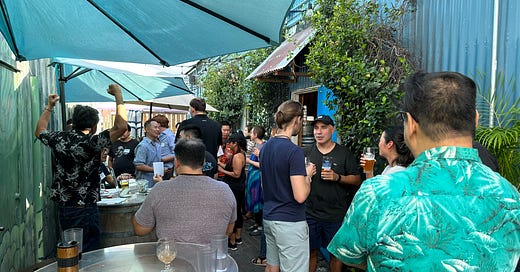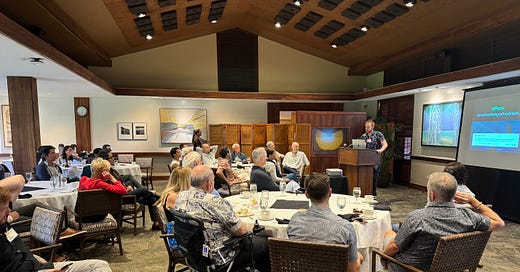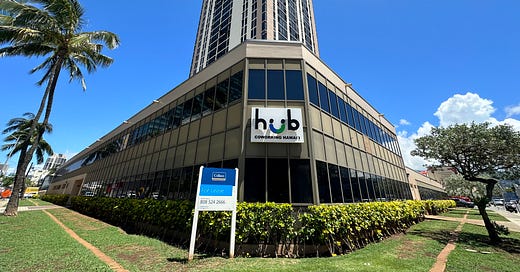
Wordle goes Hawaiian
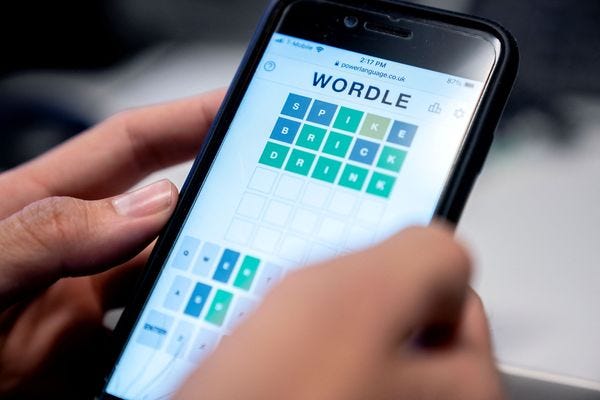
Looking for more instant interaction with members of the Hawaii tech community? Consider joining Hawaii Slack or joining Hawaii Discord, depending on your preferred chat platform. You can find me on both every day. Too much? There's always email!
There's a chance that the omnipresent cat photo has been dethroned as the primary visual currency across the social internet.
The breakout hit word game Wordle has infected our feeds with a torrent of yellow and green squares, block hieroglyphs that represent our respective successes or failures in solving a daily word puzzle.
Of course there's already a backlash, but the sweet and simple story behind Wordle's creation makes it hard to hate. I actually resisted checking it out, fearing I'd join many friends in becoming an addict. But a good journalist does his research, so I played today.
I got it in two guesses. I'm never going to top that beginner's luck.
Something that has truly "gone viral" like Wordle certainly inspires copycats, and some fun parodies. But for lovers of languages — especially once endangered, indigenous languages — it can also inspire something else.
Advancing the Hawaiian language
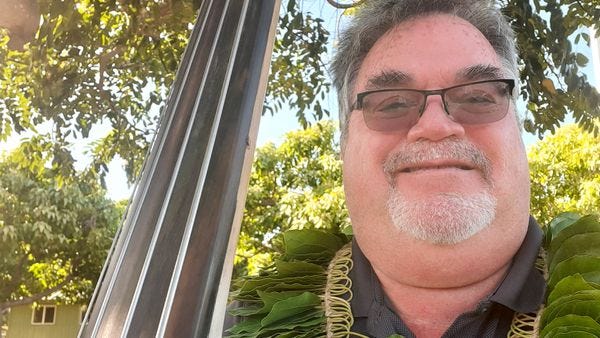
Keola Donaghy will tell you that he's a musician at heart, a teacher and writer, a researcher and humble expert. He's also a very proud grandfather.
But it's through technology that I got to know him, and became a lifelong fan. From engaging in friendly banter and periodic debate in alt.culture.hawaii on USENET in the 1990s, to exploring the early worlds of blogging and podcasting and social media, I always admired his commitment to perpetuating Hawaiian culture.
He will tell you he's not much of a programmer, but he was instrumental in expanding support for the Hawaiian language across a variety of platforms:
The creation of a networked course management system in the Hawaiian language called Leokī, based on FirstClass dial-up BBS software, in 1995. It remained in use for nearly two decades.
The Apple Macintosh operating system included a Hawaiian language keyboard as of MacOS 10.2 (Jaguar), released in August 2002.
Google added a Hawaiian language version of its search engine in 2009.
Apple added Hawaiian support in its operating system for iPhone 3.0 in June of 2009, making it easy to type Hawaiian diacriticals using the English keyboard.
The launch of Ulukau, the Hawaiian Electronic Library, in the summer of 2012. Said to be the largest and most used digital repository of indigenous language knowledge in the world, I still use it weekly.
The Windows operating system finally introduced Hawaiian language support with the launch of Windows 8 in November 2012.
Apple added a dedicated Hawaiian language keyboard in iOS 7 in 2013, displaying only the letters in the Hawaiian alphabet and including a Hawaiian language dictionary to autocorrect spelling.
The release of a Hawaiian language keyboard for ChromeOS, to support one of the more popular platforms for schools, in 2020.
And I'm certain there are a dozen more major milestones that I've missed. Suffice it to say, programmer or not, Donaghy is perhaps the person most responsible for ensuring that the Hawaiian language continues to thrive into the information age.
Amusingly, with the Windows 8 release in 2012, Keola had written: "I’m cautiously optimistic that this will be my swan song when it comes to technology and the Hawaiian language."
Instead, a decade later, he's got yet another treat up his sleeve.
A more worldly Wordle
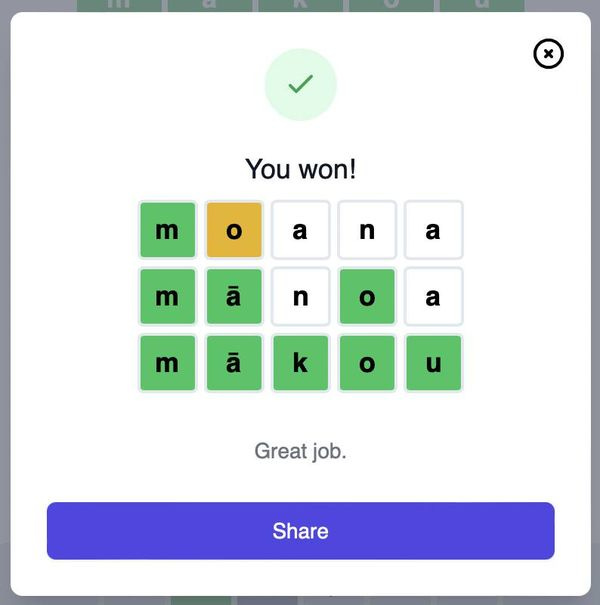
My first try at Donaghy's Hawaiian language Wordle game.
"I never even tried the original game," Donaghy tells me, as his five-year-old grandson clambers all over him. "I kept on seeing people posting their scores and didn't have really any interest in it."
It was friend and colleague Noelani Arista that opened his eyes to the international reach of Wordle's appeal. Donaghy had been studying maori for a few years, and was delighted to find Panga, an Aotearoa version of the word game.
"She's been involved in some coding projects involving indigenous languages, and she came across this guy, Aiden Pine," Donaghy recalls. "He found an open-source version of Wordle, and modified it to make it more localizable."
In fact, Pine's work was motivated by his own interest in revitalizing indigenous languages., and he's since released code and instructions for anyone to create a Wordle clone in another language.
Early adopter that Donaghy was, though, he pushed his way through on his own.
"I haven't done any coding in ages, so I had to relearn everything, including GitHub, which has space for pushing and pulling files and keeping things synchronized," he says. "Then I started using the XCode editor, installing a couple scripts and command line things.
"All that was harder than actually creating the Wordle game," he laughs.
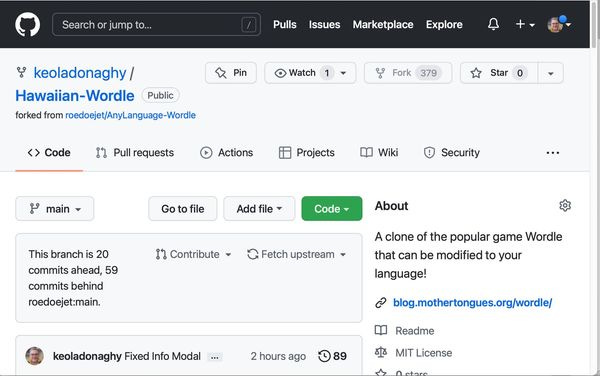
The GitHub repository for Donaghy's Hawaiian Wordle game..
As for the five-letter words?
"I have a couple of word lists, a complete list of words from the standard Hawaiian dictionary, as well as Mamaka Kaiao from my Hilo days," he explains. "I was able to pare it down and remove all duplicates, and then parse it out so that I only had five letter words."
He has 400 five-letter words, for starters, enough to last over a year given the daily puzzle schedule.
"That'll give me enough time to to work with the rest of the list and try to make it a bit more comprehensive," he says. "Right now, there are valid Hawaiian words that it's not going to accept because they're not in there."
And an important note: in the Hawaiian language, the ʻokina is a letter.
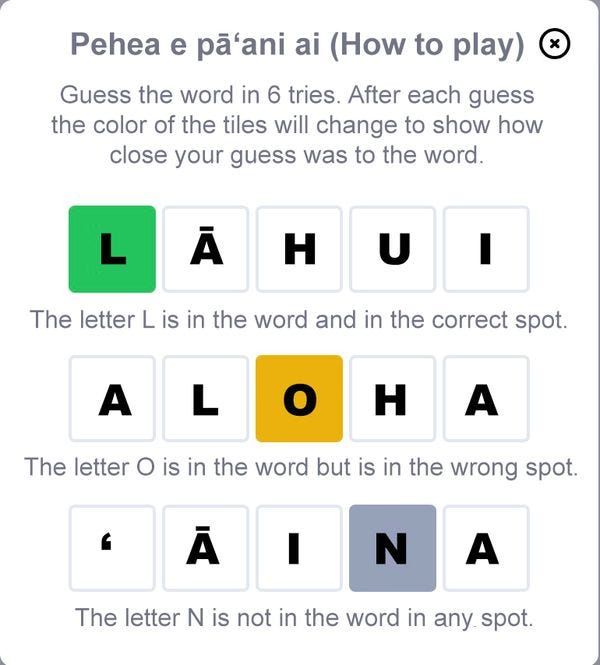
Game day and beyond
Donaghy plans to release his Hawaiian language Wordle game on Monday, February 1, the first day of Hawaiian Language Month. He's been posting updates on Twitter, gaining over 150 followers this weekend alone:
https://twitter.com/keoladonaghy/status/1487695341340090368?s=20&t=1-lpWd0zDqsIA1MZwpEVJA
The game is called "Hulihua," and can be found at Hulihua.net. Visit daily!
As for what's next, Donaghy reaffirmed his passion for music and writing, and his teaching and research work.
"Sometimes this stuff is a welcome distraction but I'm not really anxious to dive back into the tech area," he says. "Maybe at some point I'll retire and I'll jump back into the tech side of things."
On the other hand, if someone with a technical mind wants to collaborate on a Hawaiian language project, Donaghy's door is open.
"If anybody has an idea of something that would benefit ʻōlelo instruction or speakers in some way — if they have an idea for a project from the coding side, and can pull that off — I'd be willing to help with the ʻōlelo side of it.
"If it's a high value thing, if it's something that's going to service a lot of people, I'd consider it," he says.
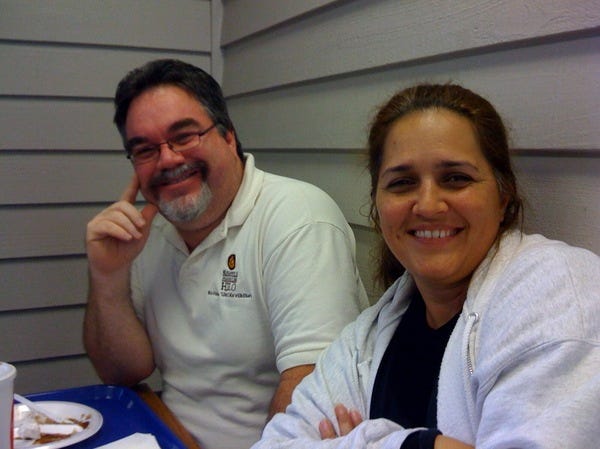
The first time I met Keola Donaghy (left) in person was at a "Tweetup" in Hilo in December 2008. At right, Luahiwa Namahoe, with whom my late wife and I attended UH Hilo in the '90s.
Worthy Reads
How Do You Say Computer in Hawaiian? (Wired, August 1995)
Aloha, You've Got Hawaiian 101 (Wired, September 2002)
Header photo by Stefani Reynolds/AFP via Getty Images.




